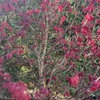Osmanthus Fragrans and Clay Soil
UcancallmeAl, Zone 7, NC
7 years ago
Featured Answer
Sort by:Oldest
Comments (17)
rhizo_1 (North AL) zone 7
7 years agoRelated Discussions
Osmanthus fragrans pH
Comments (0)Cannot find, on web, if this plant prefers acid, neutral or alkaline soil. Definitely at it's stressed out northern limit with me here....See MoreHow to raise (transplant) osmanthus fragrans planted too deep?
Comments (4)It's planting 101 for all woodies. When you purchase the replacement, always look for the slight flare at the base of the stem which you want to be at ground level when you set the woody in place. (Easier to notice on trees than on shrubs.) Sometimes container-grown or B&B are already too deep. Another key to success is to dig the hole only as deep as needed for the height of the rootball. If deeper, then filled back in, the woody will sink. It's guaranteed! Have fun shopping....See MoreTransplanting Osmanthus Fragrans and Michelia Figo
Comments (4)AnyaPerfurmer: I will try my best to find out the information about suitable location for planting Os Fragrans. It may grow in south Florida. You might have to try it. Because Osmanthus is the Regional Flower for the region of Tainan, south of Taiwan. The area is very warm, no frost and very wet and humid. Most popular and wild Os grow along Yangtze River. It has some snow and ice in Winter and hot in summer. Os will not stand the bitter cold. In Forbidden City and Summer Palace of Beijiang, There are about three hundreds of Osmanthus planted in large pots. They move the pots to the sheltered area during Winter time....See MoreOsmanthus Fragrans Questions
Comments (16)Luis, I live in Texarkana and have 30+ sweet olives. No specific kind, just o. fragrans. The ones in the shade are blooming right now. I've got some in the sun, some in the shade. The sun doesn't seem to bother them at all (and mine are in full - all day sun), and I've never had any problems out of mine. Some didn't get much water in this drought we just had, and they did fine and are blooming more than the others that are near my roses and got watered once a week. The ones in the sun look better, because they are fuller. If you want them to be full, chop them down by 1/3 each spring (after they bloom). These things will bloom during all of the cooler months. If it's not over 90 outside, or freezing at night, they are blooming. GREAT PLANT. The soil here is red clay, very acidic, not rich at all. I've never had one die from anything, not cold, not heat, not even neglect....See MoreEmbothrium
7 years agolast modified: 7 years agoEmbothrium
7 years agolast modified: 7 years agoUcancallmeAl, Zone 7, NC
7 years agolast modified: 7 years agodavidrt28 (zone 7)
7 years agolast modified: 7 years agoUcancallmeAl, Zone 7, NC thanked davidrt28 (zone 7)davidrt28 (zone 7)
7 years agoUcancallmeAl, Zone 7, NC
7 years agodavidrt28 (zone 7)
7 years agolast modified: 7 years agoken_adrian Adrian MI cold Z5
7 years agoUcancallmeAl, Zone 7, NC thanked ken_adrian Adrian MI cold Z5UcancallmeAl, Zone 7, NC
7 years agodavidrt28 (zone 7)
7 years agolast modified: 7 years agoEmbothrium
7 years agolast modified: 7 years agodavidrt28 (zone 7)
7 years agolast modified: 7 years agodavidrt28 (zone 7)
7 years agolast modified: 7 years agoEmbothrium
7 years agolast modified: 7 years agodavidrt28 (zone 7)
7 years agolast modified: 7 years ago
Related Stories

GARDENING GUIDES10 Top Native Plants for the U.S. Southeast
For a low-maintenance and wildlife-friendly landscape, use Southern natives that withstand heat and humidity
Full Story
GARDENING GUIDES6 Plants That Beat Butterfly Bush for the Wildlife Draw
It's invasive, a nonnative and a poor insect magnet. Check out these better alternatives to butterfly bush in the garden
Full Story
SPRING GARDENINGTop 10 Scented Plants for Your Garden
A palette of perfumed plants can transform even the smallest of gardens into a sensory delight
Full Story






ken_adrian Adrian MI cold Z5